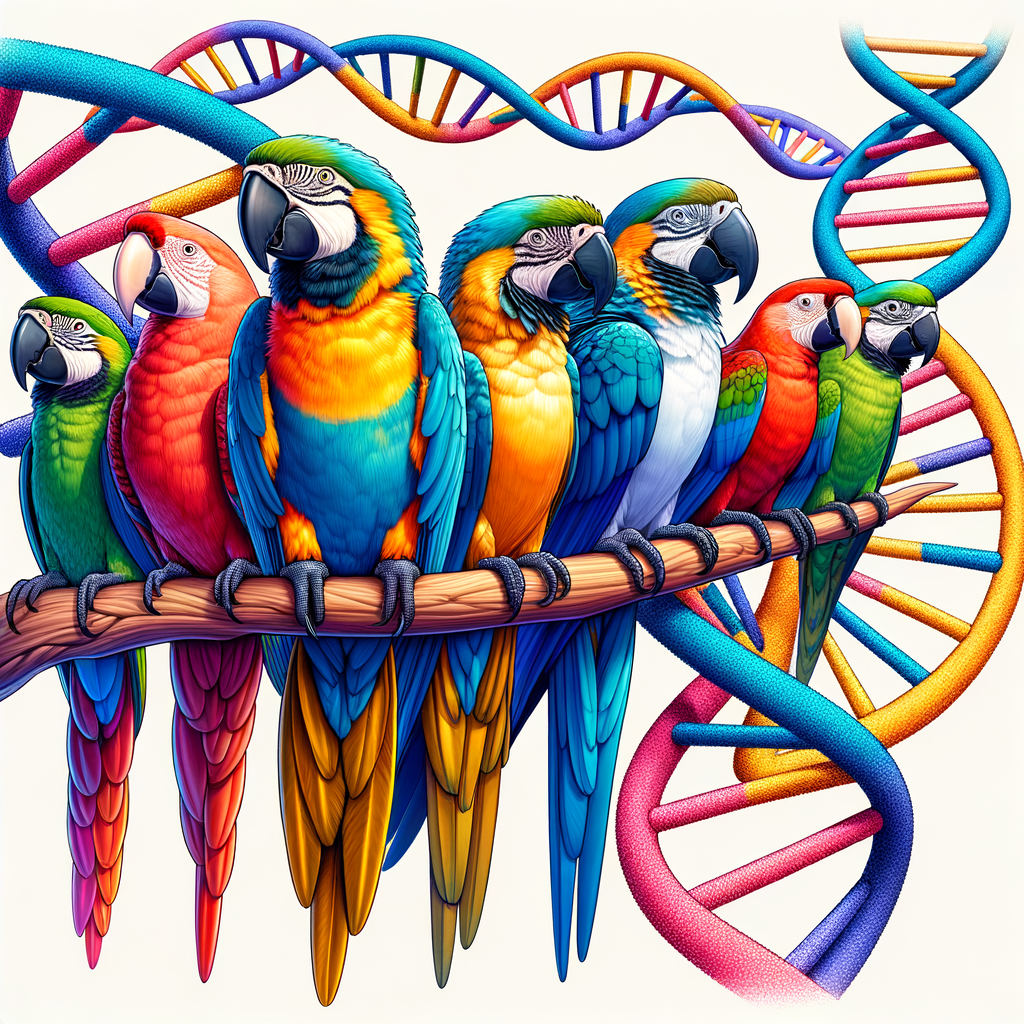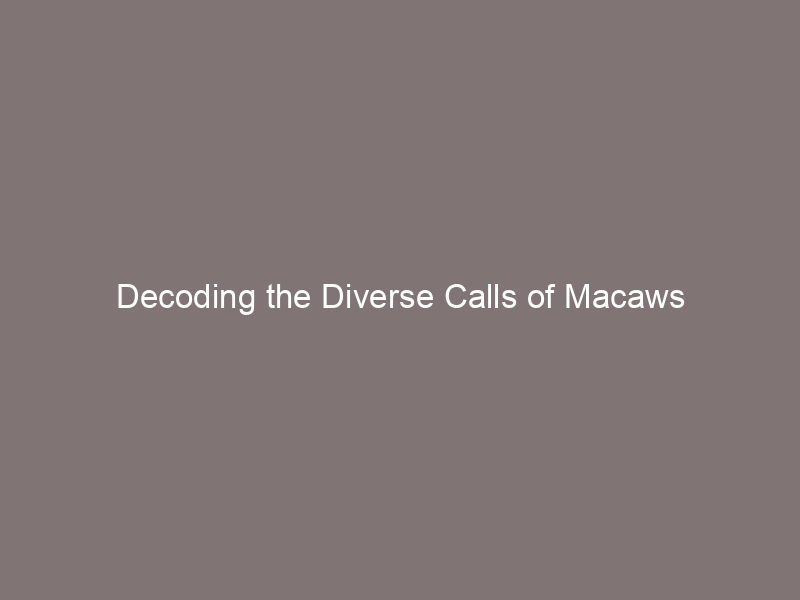
Introduction to Macaw Hybridization
Macaw hybridization is a fascinating topic that holds great importance in the bird breeding world. In this section, we will explore what macaw hybridization is, how it works, and why it is significant.
- Definition of Macaw Hybridization
- Overview of the Process
- Importance and Relevance in the Bird Breeding World
Macaw hybridization refers to the process of breeding two different species of macaws to produce a hybrid offspring. These hybrids often possess unique characteristics, combining the traits of both parent species. For example, a hybrid macaw might have the vibrant colors of one parent and the size or temperament of the other.
The process of macaw hybridization begins with the selection of two different macaw species that are compatible for breeding. The birds are then placed together in a conducive environment to encourage mating. Once the female macaw lays eggs, they are incubated until they hatch, resulting in hybrid macaw chicks. It’s important to note that not all macaw species can successfully hybridize, and the process requires careful planning and expertise.
Macaw hybridization holds significant relevance in the bird breeding world. It allows breeders to create new and unique macaw varieties, which can increase genetic diversity and help preserve endangered species. Hybrid macaws are often sought after for their unique colors and traits, making them popular in the pet trade. Additionally, studying these hybrids can provide valuable insights into macaw genetics and evolution.
In the following sections, we will delve deeper into the world of macaw hybridization, exploring the different species, the results of hybridization, and the genetics involved. So, let’s embark on this fascinating journey of understanding the blurring species lines, the role of genetics, and the future of macaw hybridization.
Blurring Species Lines: Understanding Macaw Species
Macaws are fascinating creatures with a rainbow of colors and a variety of species. Each species has unique characteristics that make them stand out. However, the lines between these species can sometimes blur due to hybridization. Let’s delve into the world of Macaws and understand them better.
- Introduction to various Macaw Species
There are about 19 species of Macaws, each with its own unique traits. Some of the most popular ones include the Blue and Gold Macaw, Scarlet Macaw, and the Green-winged Macaw. These birds are known for their vibrant colors, large size, and long lifespan. They hail from the rainforests of Central and South America, each species adapted to its specific habitat.
| Macaw Species | Color | Habitat |
|---|---|---|
| Blue and Gold Macaw | Blue and Yellow | South America |
| Scarlet Macaw | Red, Yellow, and Blue | Central and South America |
| Green-winged Macaw | Red and Green | South America |
- Unique characteristics of each species
Each Macaw species is unique in its own way. For instance, the Blue and Gold Macaw is known for its intelligence and sociability. The Scarlet Macaw, on the other hand, is recognized for its loud calls and striking coloration. The Green-winged Macaw is the second largest Macaw species and is known for its gentle nature. These characteristics not only make each species unique but also influence their behavior and interaction with their environment.
- How species lines can blur in hybridization
Hybridization is a process where two different species of Macaws breed to produce offspring with mixed traits. This can sometimes blur the lines between different Macaw species. For example, a hybrid Macaw may have the coloration of one parent and the size of the other. This can make it difficult to categorize the hybrid as belonging to one specific species. However, these hybrids often bring out the best traits of both parent species, making them a fascinating subject of study.
In conclusion, understanding Macaw species and their hybridization is not only interesting but also crucial for their conservation. As we continue to learn more about these magnificent birds, we can better appreciate their beauty and work towards preserving their natural habitats.
Hybrid Macaws: A Result of Bird Hybridization
Hybrid Macaws are a fascinating outcome of bird hybridization, a process where two different species of Macaws are bred to create a unique, new species. This process, while complex, has resulted in some of the most beautiful and exotic birds in the world.
Exotic Bird Breeding: Creating Hybrid Macaws
Creating hybrid Macaws is a meticulous process that requires expert knowledge and careful handling. Let’s delve into the process, the challenges, and a case study of successful hybrid Macaw breeding.
- Process of breeding hybrid Macaws
- Challenges in exotic bird breeding
- Case study: Successful hybrid Macaw breeding
The process of breeding hybrid Macaws begins with selecting two healthy, mature Macaws of different species. The birds are then paired together in a large, comfortable cage with plenty of food, water, and toys to stimulate their natural behaviors. The breeding process can take several months, as the birds need to bond before they will mate. Once the female lays eggs, they are carefully monitored until they hatch into baby Macaws.
Exotic bird breeding, especially of hybrid Macaws, is not without its challenges. The birds may not bond or mate, leading to unsuccessful breeding attempts. Additionally, the hybrid offspring may suffer from health issues due to their mixed genetics. It requires patience, persistence, and a deep understanding of Macaw behavior and genetics to successfully breed hybrid Macaws.
One notable case of successful hybrid Macaw breeding is the creation of the Harlequin Macaw, a hybrid of the Blue and Gold Macaw and the Green-winged Macaw. This hybrid Macaw is known for its vibrant colors and playful personality. The success of the Harlequin Macaw breeding demonstrates that with careful planning and expert knowledge, hybrid Macaws can thrive.
In conclusion, hybrid Macaws are a testament to the wonders of bird hybridization. Despite the challenges, the creation of these beautiful and unique birds is a rewarding endeavor for those dedicated to the art of exotic bird breeding.
Macaw Breeding: A Deep Dive into Parrot Hybridization
Macaw breeding, particularly the creation of hybrid species, is a fascinating and complex process. It involves a deep understanding of genetics, careful consideration of the impact on the Macaw population, and a keen awareness of the broader implications for biodiversity. Let’s delve into these aspects in more detail.
- Understanding the Genetics Involved in Macaw Breeding
- Impact of Hybridization on the Macaw Population
- Case Study: Impact of Parrot Hybridization on Biodiversity
Macaw breeding is a science that requires a deep understanding of avian genetics. Each Macaw species has its unique genetic makeup, which determines its physical characteristics and behaviors. When two different species mate, their offspring, or hybrids, inherit a mix of these traits. This process, known as hybridization, can result in Macaws with unique colors and patterns.
| Macaw Species | Color | Size |
|---|---|---|
| Blue and Gold Macaw | Blue and Yellow | Large |
| Scarlet Macaw | Red, Yellow, and Blue | Large |
| Hyacinth Macaw | Blue | Extra Large |
While hybrid Macaws can be visually stunning, hybridization has a significant impact on the Macaw population. It can lead to a decrease in purebred Macaws, which can affect the genetic diversity of the species. This is a concern as genetic diversity is crucial for the survival and adaptability of a species.
A study on parrot hybridization provides a clear picture of its impact on biodiversity. The study found that while hybridization can lead to unique and beautiful variations, it can also blur the lines between species. This can make it challenging to maintain the distinct characteristics and behaviors of each species, which are essential for biodiversity.
In conclusion, while Macaw hybridization can result in visually stunning birds, it’s essential to understand the genetic implications and the potential impact on the Macaw population and biodiversity. As we continue to explore the world of Macaw breeding, we must strive for a balance that respects and preserves the natural diversity of these magnificent birds.
Crossbreeding Macaws: A Look into Macaw Genetics
When we talk about the beautiful and vibrant Macaws, we often marvel at their stunning colors and sizes. But have you ever wondered how these features come to be? The answer lies in the fascinating world of genetics. In this section, we will delve into the role of genetics in crossbreeding Macaws, how it determines the color and size of hybrid Macaws, and key takeaways in understanding the science behind Macaw genetics.
- Role of genetics in crossbreeding Macaws
Genetics plays a crucial role in crossbreeding Macaws. When two different species of Macaws mate, their genes combine to create a hybrid offspring. This offspring carries traits from both parent species. The process is similar to how human children inherit traits from their parents. For example, a Scarlet Macaw and a Blue and Gold Macaw might produce a Catalina Macaw, a hybrid with a mix of the parents’ colors and features.
- How genetics determine the color and size of hybrid Macaws
The color and size of hybrid Macaws are determined by the genes they inherit from their parents. Each parent Macaw contributes one set of genes to the offspring. These genes carry instructions for everything from the color of the bird’s feathers to its size. For instance, if one parent has a gene for blue feathers and the other parent has a gene for yellow feathers, the offspring might have green feathers. Similarly, if one parent is larger than the other, the offspring’s size will likely fall somewhere in between.
- Key takeaways: Understanding the science behind Macaw genetics
Understanding the science behind Macaw genetics can be complex, but here are some key takeaways. First, genetics plays a vital role in crossbreeding Macaws and determining the traits of the hybrid offspring. Second, the color and size of hybrid Macaws are determined by the genes they inherit from their parents. Lastly, while genetics can predict certain traits, there’s always room for surprises, which is part of the beauty and excitement of Macaw crossbreeding.
To summarize, the world of Macaw genetics is a fascinating one. By understanding it, we can appreciate the diversity and beauty of these birds even more. So the next time you see a Macaw, remember that its stunning colors and size are the result of a complex genetic dance.
| Macaw Species | Color | Size |
|---|---|---|
| Scarlet Macaw | Red, yellow, blue | 32 inches |
| Blue and Gold Macaw | Blue and yellow | 34 inches |
| Catalina Macaw (Hybrid) | Mix of parents’ colors | Variable, typically between parent sizes |
Conclusion: The Future of Macaw Hybridization
As we reach the end of our journey into the fascinating world of Macaw hybridization, let’s take a moment to reflect on where we are now and where we might be heading in the future.
- Current trends in Macaw hybridization
- Potential future developments
- Final thoughts on the colorful journey into species blending
Today, the practice of Macaw hybridization is becoming increasingly popular. Breeders are continually exploring new combinations, resulting in a dazzling array of hybrid Macaws with unique colors and traits. For instance, the Harlequin Macaw, a hybrid of the Blue and Gold and Green-winged Macaw, is admired for its vibrant plumage and playful personality.
Looking ahead, we can expect to see even more exciting developments in Macaw hybridization. Advances in genetic science may open up new possibilities for creating hybrids with specific traits. Imagine a Macaw with the intelligence of an African Grey and the stunning colors of a Scarlet Macaw! However, it’s essential to remember that ethical considerations should always guide our actions in this field.
Macaw hybridization is indeed a colorful journey into species blending. It’s a testament to the beauty of nature and the ingenuity of human beings. However, as we continue to push the boundaries of what’s possible, we must also remember to respect the natural order and ensure the well-being of these magnificent creatures.
In conclusion, the future of Macaw hybridization is bright and full of potential. But as we marvel at the beauty of these hybrid Macaws, let’s also remember our responsibility to protect and preserve the natural diversity of the Macaw species.






